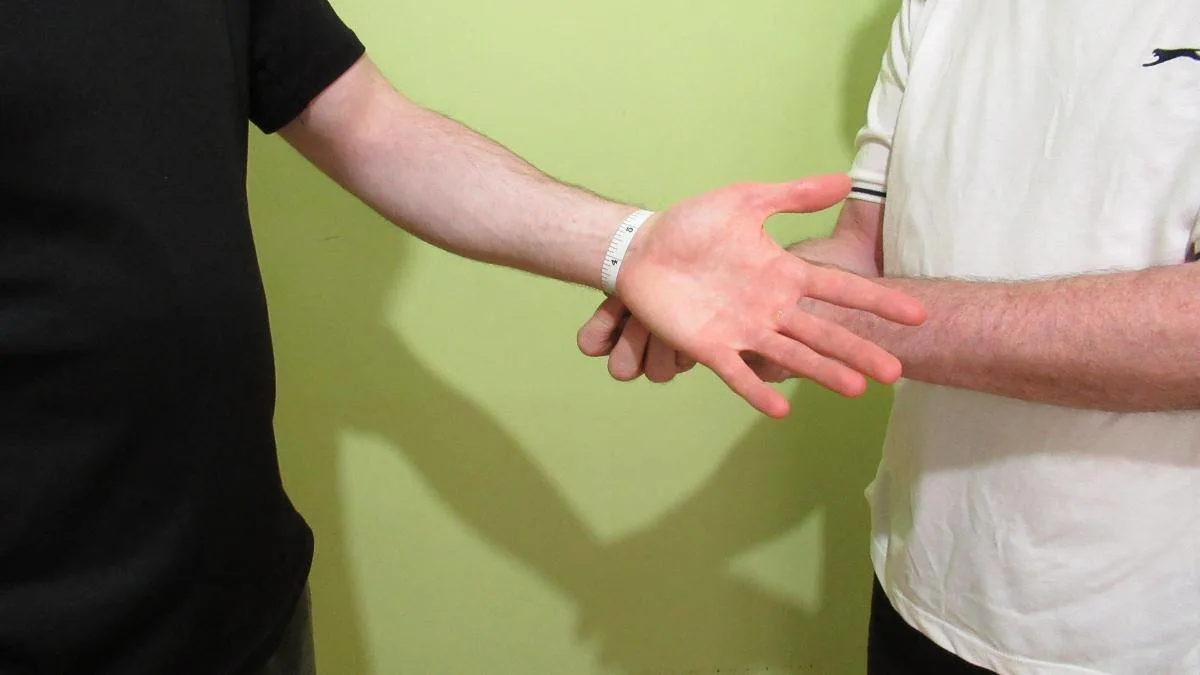If you want to find out the average wrist size for men, women, and teenagers, then you’re in the right place.
We poured through pages and pages of wrist measurement data—surveys, polls, scientific reports, anthropometric research—so that we could give you the most accurate information on the average wrist circumference and how that relates to your age, height, and frame size.
Later on, we’ll also show you how to find your wrist size using a variety of measuring tools, which will be useful if you want to buy a new watch, a bracelet, or if you want to determine your body frame size.
Related Measurement Guides:
- Average hip circumference
- Average male waist size by age
- Average human neck circumference
- Average shoulder breadth
- Normal forearm size
- Average ankle size
What is the average wrist size for a woman?
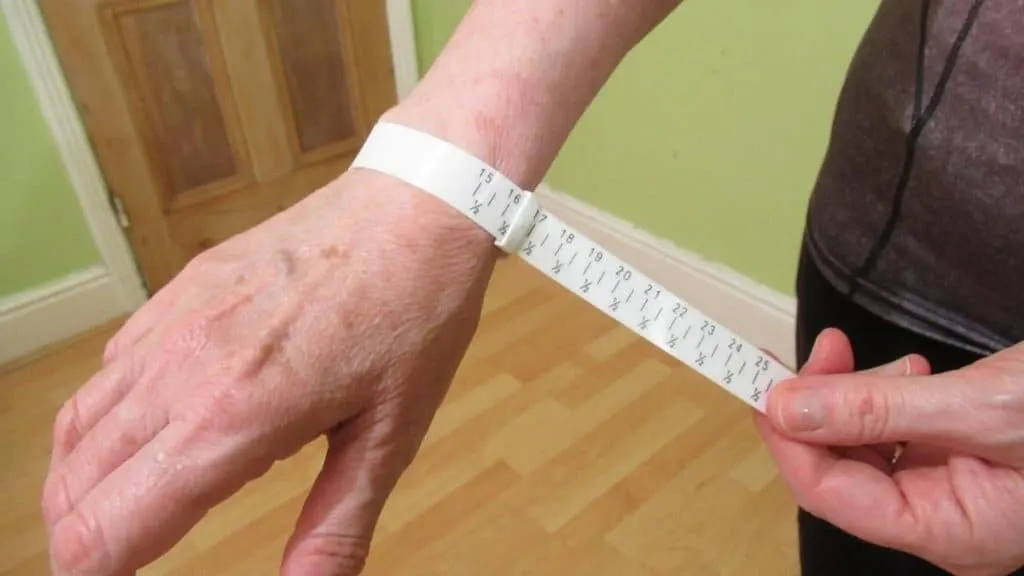
What is the average wrist size for a woman? According to MedlinePlus, which is a service from the National Library of Medicine, the average women’s wrist size is between 5.5 inches and 6.5 inches (13.97 cm to 16.51 cm). [1]
As noted in the article, the average female wrist size tends to increase with height, seeing as taller people usually have larger bones than shorter people.
The above data is perfectly supported by a 1995 anthropometric survey of US military personnel, which, among other things, measured the wrist circumference of 2888 women. The researchers found that the average woman’s wrist size was 5.94 inches, which is equal to 15.08 cm, or around 151 mm. [2]
What is the average male wrist size?
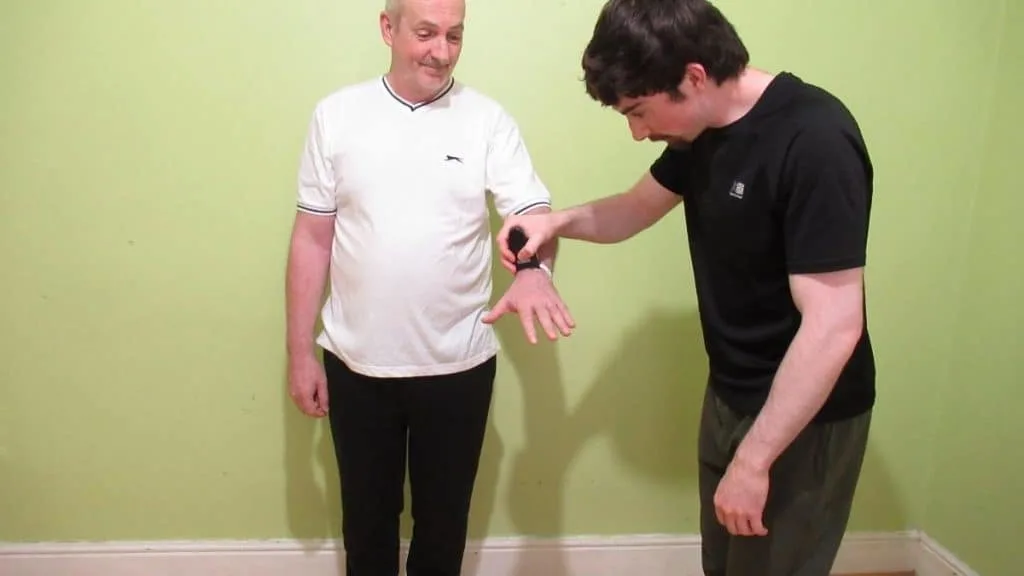
What is the average wrist size for a man? According to US anthropometric data taken from Marine Corps personnel, the average male wrist size is 6.85 inches (17.39 cm).
The average male wrist size in mm is right around 174 mm (millimeters), according to the report, which measured the wrist circumference of 4447 men.
Once again, this data tallies nicely with more recent research. Indeed, based on anthropometric data published by the U.S. Army Natick Soldier Systems Center in 2017, the average male wrist circumference was found to be 172 mm, which is equal to 17.2 cm or 6.77 inches. [3]
A 2018 poll of 175 men on the Time Factors watch forum found that the average male wrist size in inches was 6.75 inches. [4] This again corresponds with the US data cited above, indicating that most men have wrists that measure just under 7 inches in circumference.
Compare Your Wrist Circumference:
- 2 inch wrist
- 4 inch wrist
- 5 inch wrist
- 6 inch wrist
- 7 inch wrist
- 8 inch wrist
- 9 inch wrist
- 10 inch wrist
What is the average wrist circumference for a teenage girl?
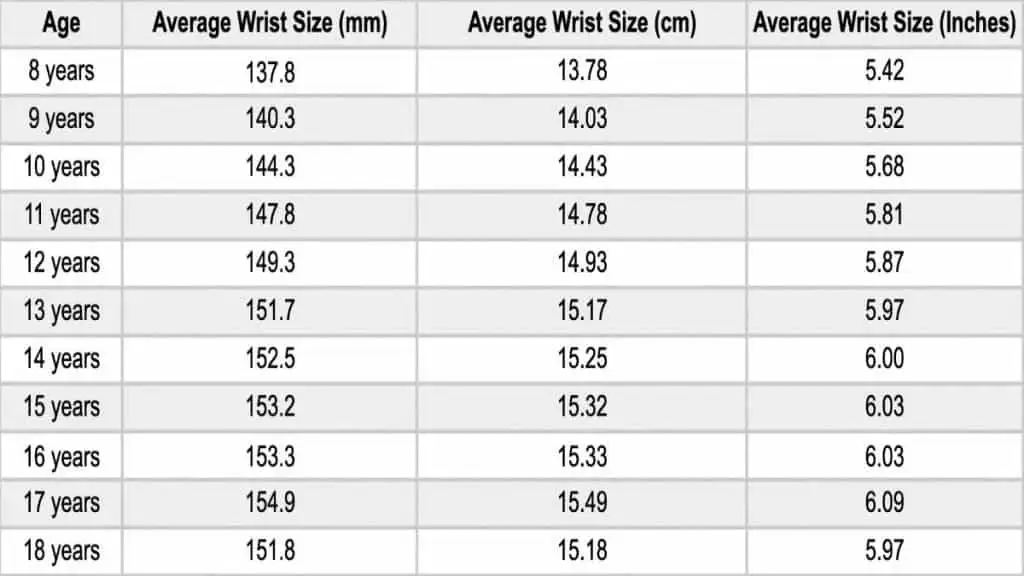
As you would expect, the average wrist circumference for a teenage girl is heavily dependent on the age of the girl, with older girls tending to have thicker wrists than younger girls.
The following data, which is broken down by age, is taken from the Census at School, which is run by the Statistical Society of Canada. [5]
I believe the following measurements to be fairly representative of teenagers in general, and the data certainly has validity in other Western countries.
The average wrist measurement for a 13-year-old girl is 5.97 inches (15.17 cm).
The average wrist size by age in inches for a 14-year-old girl is exactly 6 inches, which is equal to 15.25 cm.
A normal wrist size for a 15-year-old girl was found to be 6.03 inches or 15.32 cm. This was the same for 16-year-old girls.
A normal wrist circumference for a 17-year-old girl was found to be 6.09 inches or 15.49 cm.
Finally, for 18-year-old girls, the average wrist measurement is right around 5.97 inches or 15.18 cm.
As you can see on the wrist measurement chart, the wrists of teenage girls tend to stop getting thicker at around age 14, which is towards the end of a girl’s pubertal period.
What is the average wrist circumference for a teenage boy?
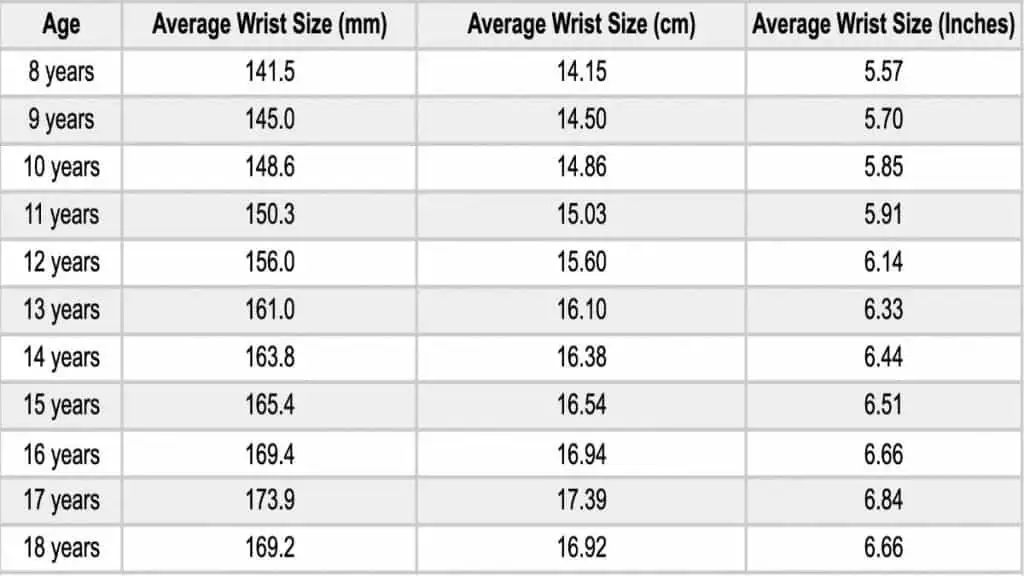
As you can see on the above wrist circumference chart, the average wrist circumference for a teenage boy tends to increase with age and doesn’t level off at age 14 like it does with girls.
Once again, this data is taken from a Canadian Census at School report, which has proven to be very reliable.
Indeed, you’ll find very similar measurements in other anthropometric data sets, including the referenced wrist circumference measurements for Turkish children and adolescents. [6]
With that said, here is the average wrist size by age in cm and inches for male teenagers.
The average wrist girth measurement for a 13-year-old boy is 16.10 cm or 6.33 inches.
For a 14-year-old boy, the average wrist size measurement is 16.38 cm or 6.44 inches.
For a 15-year-old boy, the typical wrist size is right around 16.54 cm or 6.51 inches.
The typical wrist circumference for a 16-year-old boy is 16.94 cm or 6.66 inches.
The average wrist circumference measurement for a 17-year-old boy is 17.39 cm or 6.84 inches.
Finally, the standard wrist size for a male 18-year-old is 16.92 cm or 6.66 inches.
What is the average wrist width and diameter?
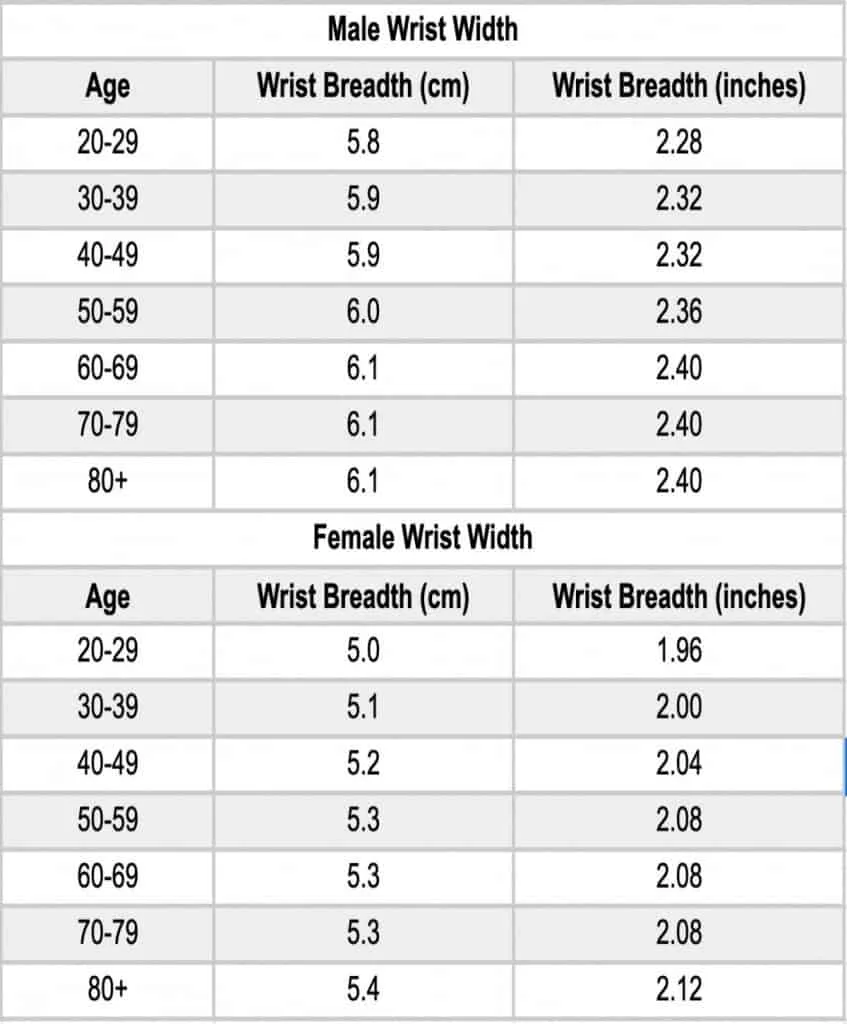
What is the average wrist width? According to US anthropometric data taken from the CDC’s Vital and Health Statistics report, the average wrist width is 5.9 cm (2.28 inches) for men and 5.2 cm (2.04 inches) for women. [7]
This data is based on the wrist breadth measurements (also commonly called wrist span and wrist diameter) of 7,501 men and 8,162 women aged 20 and older.
What’s interesting is that the average wrist diameter for both men and women tends to increase slightly with age. For example, women aged 20-29 have an average wrist diameter of 5 cm, whereas women aged 80+ have an average wrist width of 5.4 cm, almost an 8% size difference.
Women’s wrist size chart
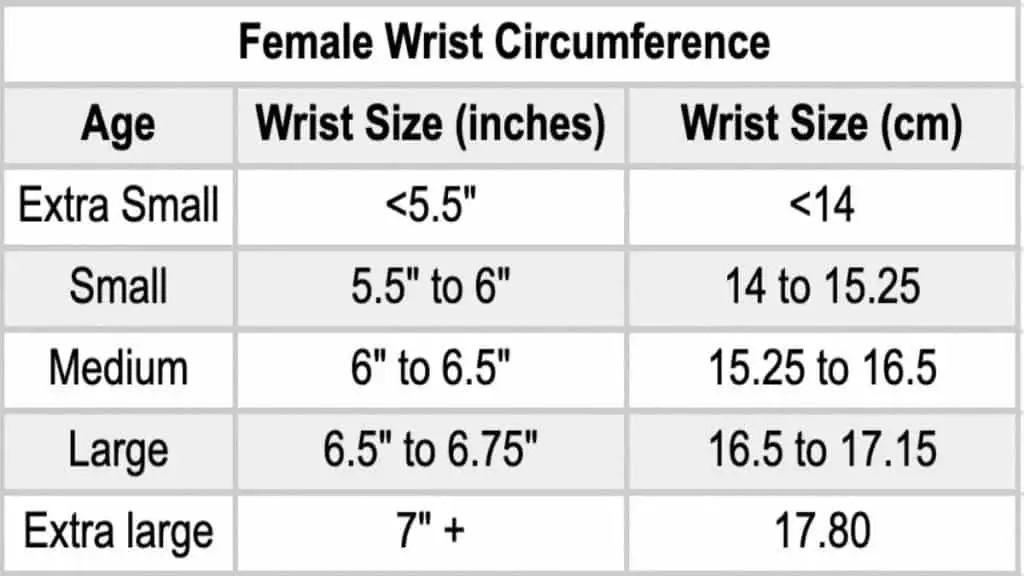
This women’s wrist size chart is based on wrist girth measured with a tape and will help you to figure out whether your wrists are small, medium, or large in terms of circumference.
Note that these measurements are for women of a relatively normal height. If you’re significantly shorter or taller than average, then your wrists might be a different size, which could be perfectly normal for your frame size.
Men’s wrist size chart
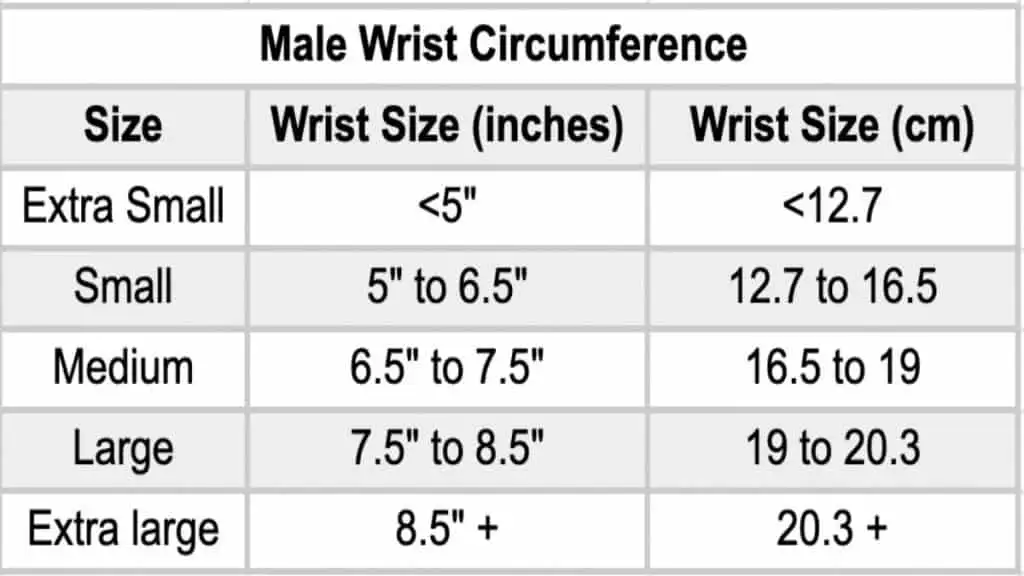
This men’s wrist size chart was created using data from a variety of sources, including published anthropometric research and expert health authorities.
This wrist sizing chart will help men like you to figure out whether they have small, medium, large, or extra large wrists, which, in turn, will give you an insight into your frame size. More on that later.
How to measure your wrist size (5 ways)
If you want to learn how to measure your wrist size for a new watch, a bracelet, or just to determine your wrist circumference, then you’re in the right place.
This section will show you how to figure out your wrist size using a variety of wrist measurement tools. So no matter what measuring equipment you have at your disposal, you’ll easily—and accurately—be able to determine the circumference of your wrists.
How to measure your wrist circumference with a tape measure
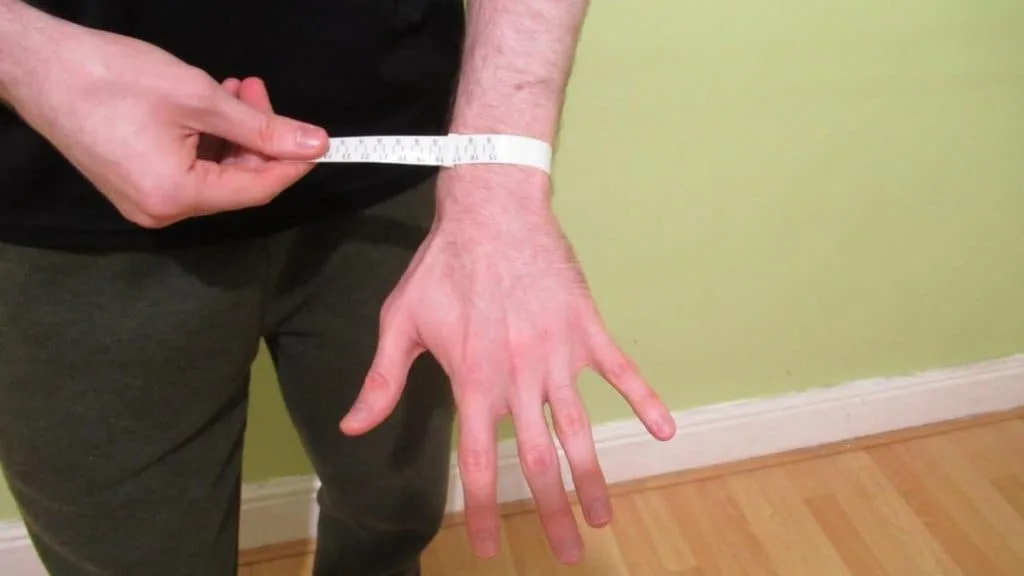
First and foremost, let me explain how to measure your wrist circumference with a tape measure, as this is the most convenient way to determine your wrist size.
- Wrap a flexible tape measure around your wrist just below the bone.
- Open your hand so that your fingers are separated.
- Observe where the ends of the tape overlap; that’s your wrist circumference measurement.
- Take another 1-2 wrist measurements to verify your circumference.
How to measure your wrist size without a tape measure
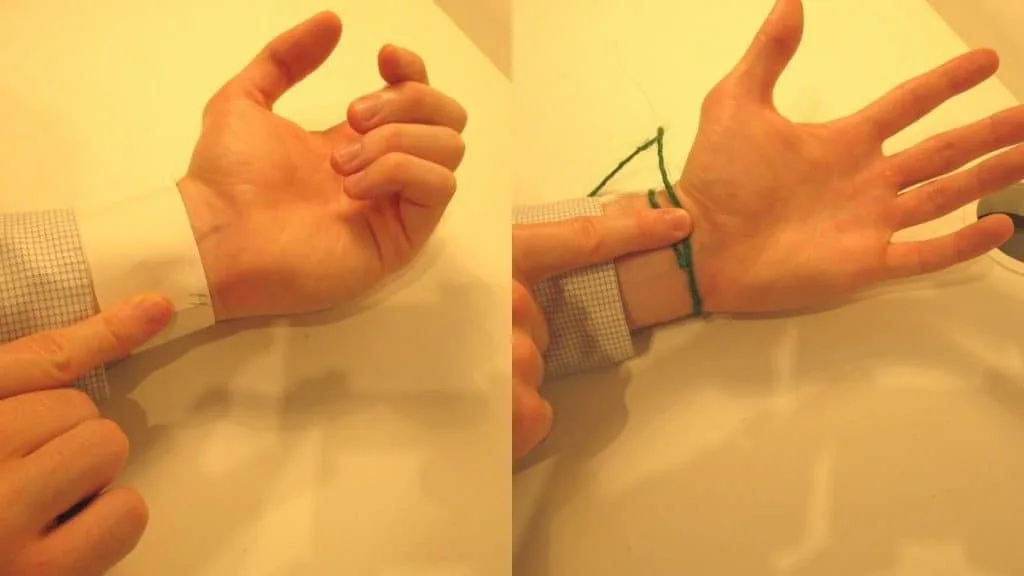
Now you’re going to learn how to measure your wrist size without a tape measure—and there are multiple ways to do it.
My favorite way to measure your wrist circumference without a tape measure is to use a piece of string. Why? Because, like a tape measure, the string is flexible and wraps snugly around your wrist, which gives you a really precise measurement.
Essentially, you wrap the string around your wrist, and then, using a pen, you simply mark where the ends overlap. Then, to get your wrist girth measurement, you just measure between these two points.
The second way to measure your wrist without a tape measure is with a simple piece of paper. All you do is cut (or tear) a thin strip from a regular sheet of paper so that it can fit around your wrist like a tape measure.
Then, you just wrap the paper around your wrist and mark where the ends overlap. Finally, you measure between these two points using a ruler or tape measure to determine your wrist circumference.
How to measure your wrist with your fingers (wrist girth test)
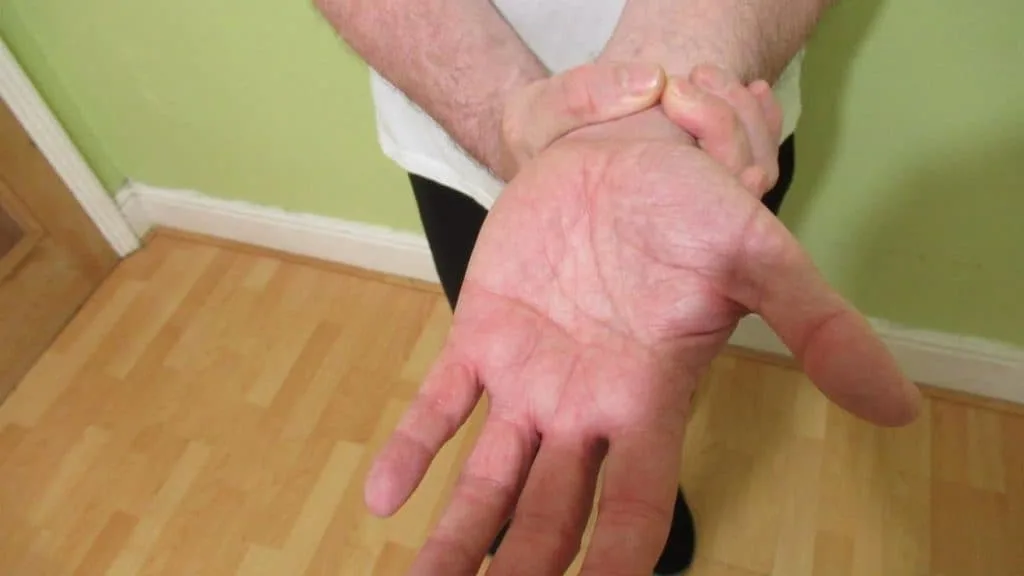
Although measuring your wrist with your fingers won’t give you a wrist measurement in inches, cm, or mm, it will help you to determine how big your wrists are, which, in turn, will tell you something about your frame size.
First, place your wrist out in front of you and open your fingers (your wrist will be slightly bigger when your fingers are spaced apart). Then, wrap the thumb and forefinger of your opposite hand around your wrist.
If your thumb and finger overlap, then you have a small frame. If they touch but don’t really overlap, then you have a medium frame. Finally, if there’s a gap between your thumb and forefinger, then you have a large frame.
You’ll learn more about the relationship between your wrist circumference and your frame size later on. But essentially, while the size of your wrist is one way to quickly gauge your frame size, there’s a lot more that goes into determining your frame size and muscular potential than just the girth of your wrists.
How to measure your wrist width
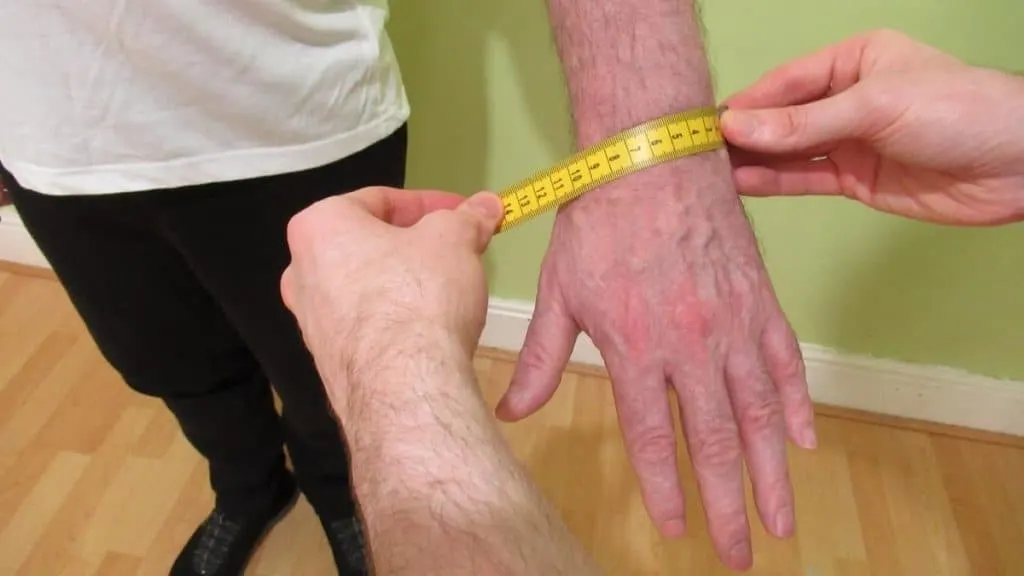
Measuring your wrist width or wrist diameter is important when you’re buying a new watch. As such, you definitely want to use a proper tape measure so that you can get a watch that fits you properly.
To measure your wrist width, look at your hand when it’s in a palm-down position and locate the two bony parts on the outside of your wrist. Then, measure between these two bones (i.e., the width of the outside/top of your wrist) to get your wrist diameter.
Selecting a good wrist measurement tool
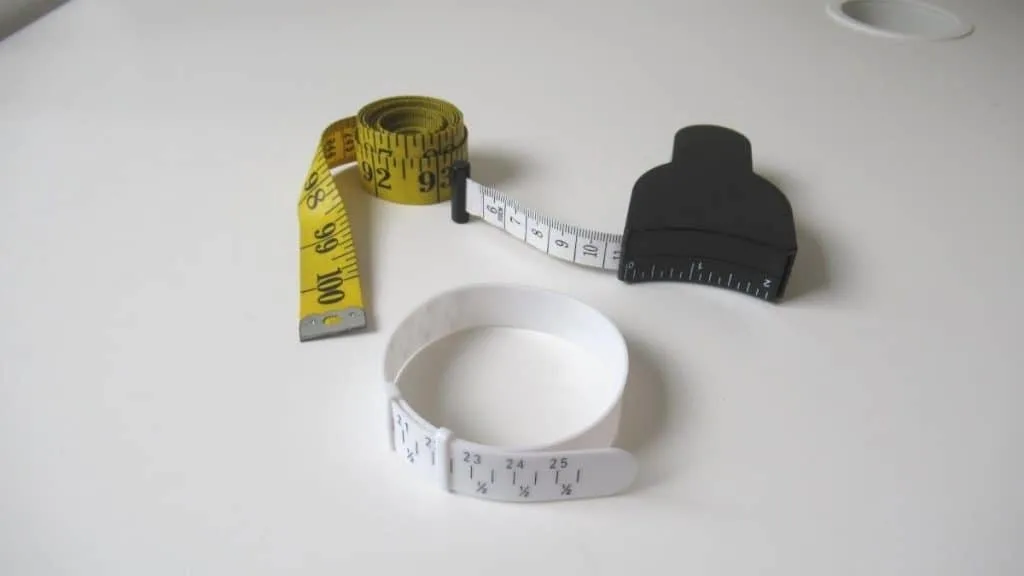
While it’s possible to measure your wrist circumference with a piece of string or even a sheet of paper, by far the most convenient and accurate way to determine your wrist size is to measure your wrists with a proper tape measure.
In this regard, you have two choices; a flexible tape measure used for taking general body measurements or a smaller tape specifically used for measuring the wrist.
The latter option is more convenient because, by using a small tape measure, you don’t have to deal with such a long and unwieldy wrist measurement tool, which will help you to keep the tape close to your wrist and get an accurate circumference measurement.
When you use a dedicated wrist measurement tool, your wrist circumference will likely be a tiny bit smaller than when you measure your wrists with a general body tape measure because you’ll be able to keep the wrist measurement tool closer to your skin.
Wrist measurement FAQ
Learn everything there is to know about wrist measurements with this helpful FAQ and wrist size guide.
What is the average male wrist size by height?
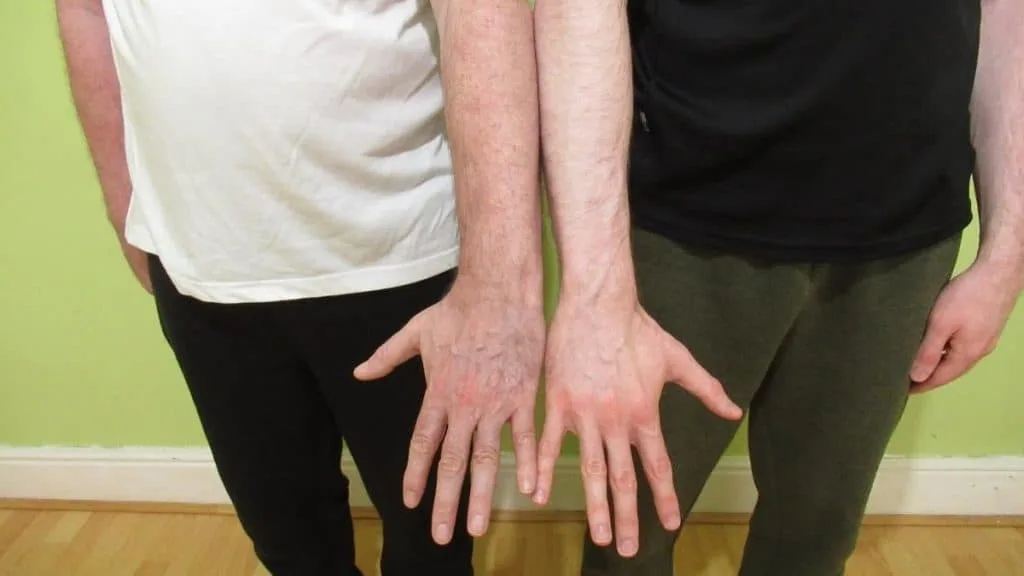
Although there is no data that specifically examines the average male wrist size by height, we know from both scientific research and observation that wrist circumference and frame size both tend to increase with height.
Indeed, one study found that wrist girth correlated with height and weight in children and adolescents, which suggests that people with larger skeletal frames in general tend to have bigger wrists as well. [8]
Much of this research focuses on children so that practitioners and public health workers can assess the growth of children to see if they’re developing at the normal rate.
Still, the same very likely holds true for adults. After all, a man who’s 5′6″ is almost always going to have significantly smaller wrists than a man who’s 6′6″.
What is the average female wrist size by height?
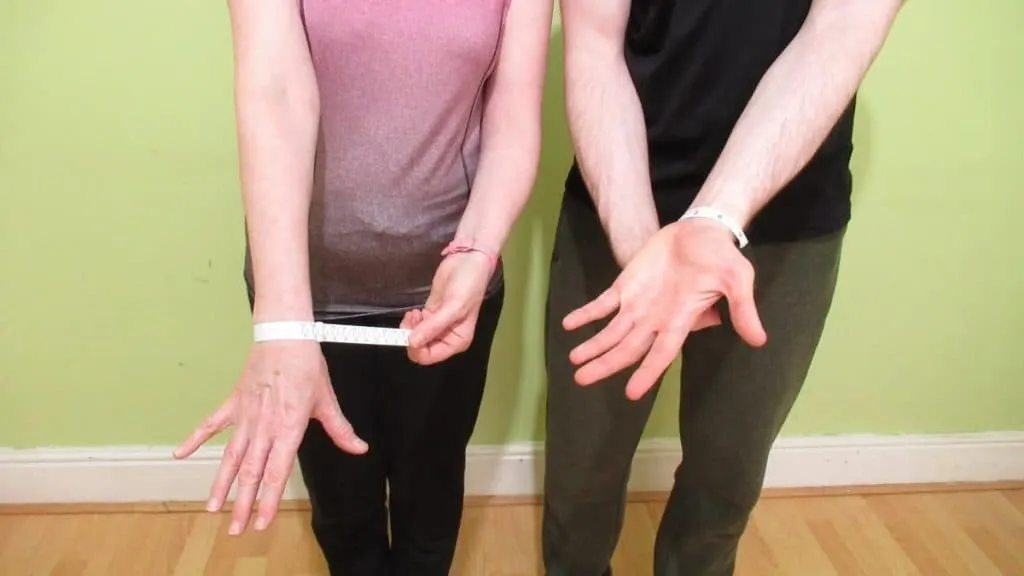
Again, there is no scientific data that directly examines the average female wrist size by height. However, as I noted earlier, the average female wrist size, which is around 6 inches, tends to increase with height.
There are, of course, short women with big wrists and tall women with small wrists. Still, the generalization holds true most of the time because a bigger frame means bigger joints which, for our purposes, means bigger wrists as well.
This claim is supported by research that examined the wrist width of 123 women. The authors of the study found that wrist width (a good indicator of wrist size) correlated with age, body size, and lean mass. [9] So, in general, women with bigger wrists tend to have more body mass and larger skeletal structures.
In summary, there’s no chart that I can create or source that will show you average wrist size by height for males and females because the data simply doesn’t exist. But such novel research would certainly be useful for anyone interested in anthropometry.
What is the average wrist size by age?

What is the average wrist size by age? In the section on teenage wrist size, I explained that wrist circumference tends to increase with age during puberty. This occurs until around age 14 for girls and age 18 to 19 for boys.
Additionally, other previously cited anthropometric research that examined the wrist breadth of adults found that wrist width also tends to increase with age. [7] For example, 80 years olds had wider wrists than 20-year-olds and 30-year-olds.
In general, circumference measurements tend to decrease with age due to sarcopenia. But the fact that the wrists appear to grow larger with age suggests that the wrists may keep growing after puberty.
So while I couldn’t find a specific wrist size chart by age in terms of circumference, there is certainly a trend for wrist size to increase well into adulthood and old age when assessed by width.
What is the average wrist size in the UK?

What is the average wrist size in the UK? Based on data that contains the wrist circumference measurements of various Western populations, the average wrist size in the UK is 6.5 inches to 7 inches for men and 5.5 inches to 6 inches for women.
Specific UK data concerning the average wrist circumference in males and females is hard to come by.
However, most people would agree that Brits have similar anthropometric measurements to Americans in terms of their bone structure, so the measurements cited throughout this article will almost certainly apply to people living in the UK.
How does your wrist size affect your body frame?
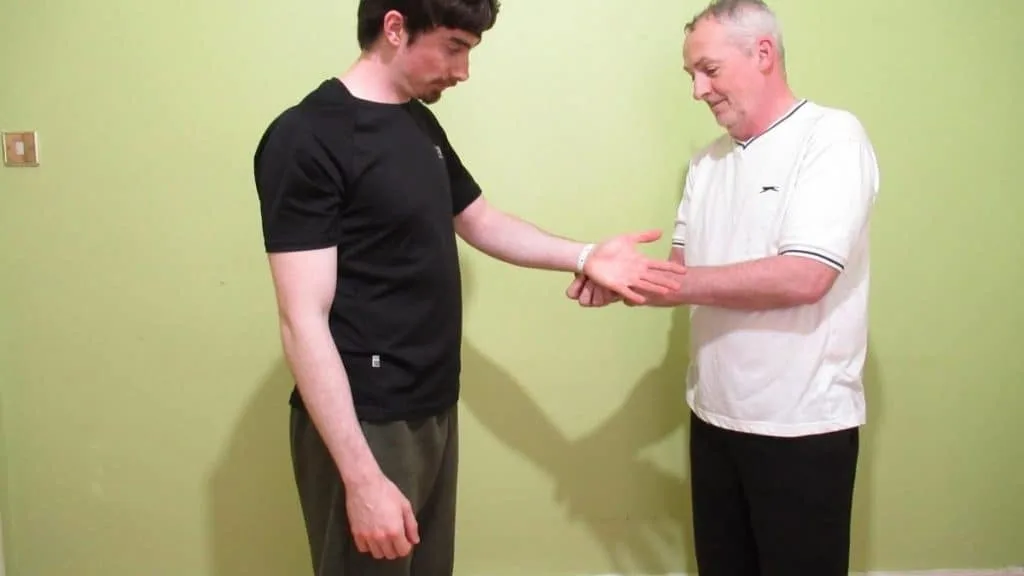
There is a strong relationship between wrist size and body frame. Those with larger wrists tend to have a bigger frame overall, which is to say, longer bones and more skeletal mass.
Although people with big wrists usually have thick joints in general, frame size can also be determined on a per joint basis. For example, you could theoretically have really long clavicles but fairly average wrists.
The opposite of this is also true; you could have narrow shoulders and big wrists.
In general, however, people with big frames overall tend to have large wrists, which often means that taller individuals have bigger wrists than shorter individuals.
What is a small wrist size?
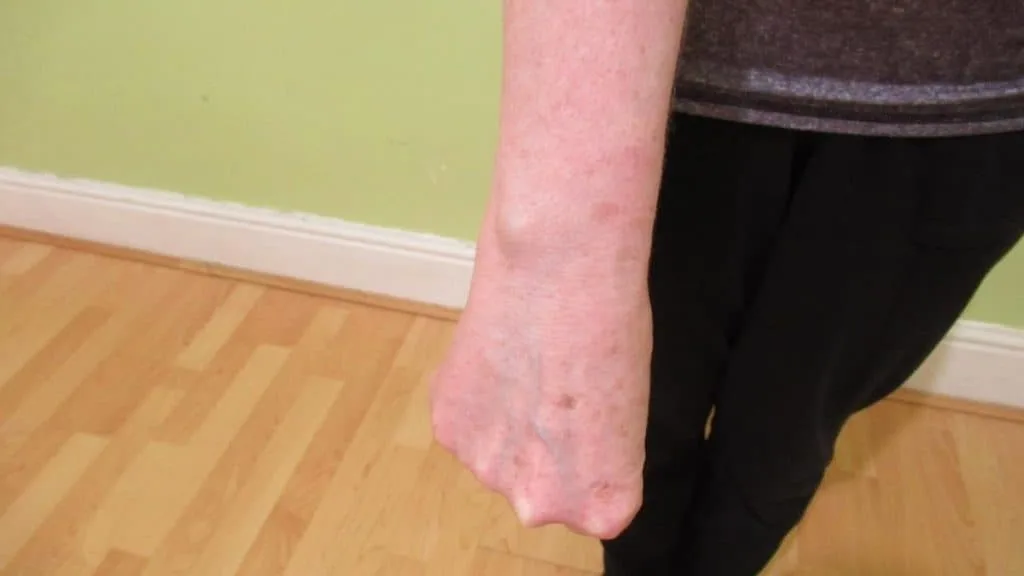
What is a small wrist size? For men, a small wrist size is anything under 6.5 inches, whereas a small wrist measurement for women is anything under 5.5 inches.
Note that these values are generalizations that hold true for people of a fairly average height and build. If you’re a short woman, for example, then 5.5 inches might be considered a normal wrist size rather than a small wrist size.
What is considered a medium wrist size?
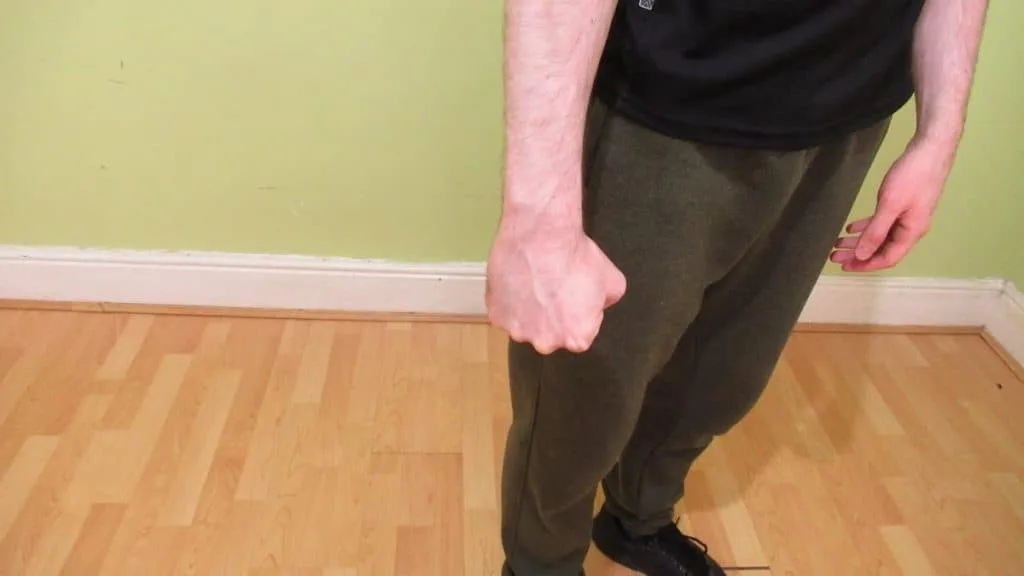
What is considered a medium wrist size for men and women? For men, a medium sized wrist is between 6.5 inches and 7.5 inches, whereas for women, a medium size wrist is between 6 inches and 6.5 inches.
What is considered a large wrist circumference?
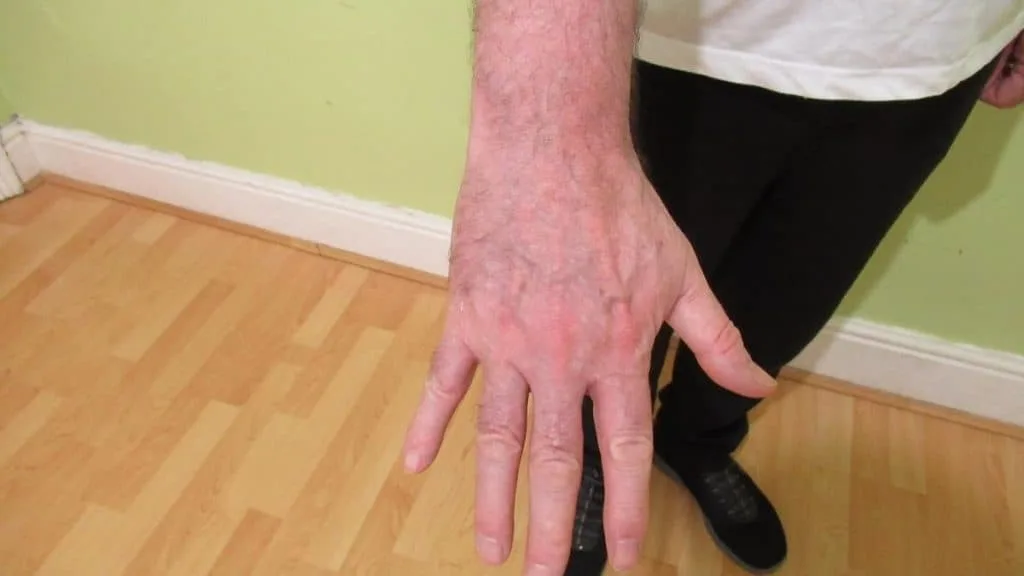
What is considered a large wrist circumference for males and females? In general, a large wrist size for males is 7.5 inches and above. For females, a large wrist size is 6.5 inches and above.
Conclusion: Is it good to have a normal wrist circumference?

Now that you know the average wrist size for women and men, you probably know whether your wrists are big, small, or medium. So, with that in mind, is it good to have a normal wrist circumference?
Having a certain wrist size is neither good nor bad; it’s simply an anthropometric measurement that can tell you something about your frame size.
As mentioned, there are other measurements to consider when assessing your frame size, but calculating your wrist circumference can certainly give you a quick indication of whether you’re small-boned, large-boned, or somewhere in the middle.
So, in summary, having an average wrist girth measurement is one indication that you have a medium-sized build.
References
- MedlinePlus. (2020). Calculating body frame size. https://medlineplus.gov/ency/imagepages/17182.htm
- Donelson, S. M., & Gordon, C. C. (1996, September). 1995 Matched Anthropometric Database of U.S Marine Corps Personnel: Summary Statistics. https://www.humanics-es.com/ADA316646.pdf
- Mitchell, K. B., Choi, H. J., & Garlie, T. N. (2017). Anthropometry And Range Of Motion Of The Encumbered Soldier. U.S. Army Natick Soldier Research, Development and Engineering Center. https://apps.dtic.mil/sti/pdfs/AD1028746.pdf
- Average wrist size. (2018). Https://Forum.Tz-Uk.Com. https://forum.tz-uk.com/showthread.php?416517-Average-wrist-size
- Average wrist circumference, by age. (2012, July 11). Census at School | Recensement à l’école. https://censusatschool.ca/data-results/2006-07/wrist-circumference/
- Öztürk, A., Çiçek, B., Mazıcıoğlu, M. M., Zararsız, G., & Kurtoğlu, S. (2017). Wrist Circumference and Frame Size Percentiles in 6-17-Year-Old Turkish Children and Adolescents in Kayseri. Journal of clinical research in pediatric endocrinology, 9(4), 329–336. https://doi.org/10.4274/jcrpe.4265
- McDowell MA, Fryar CD, Ogden CL. Anthropometric reference data for children and adults: United States, 1988–1994. National Center for Health Statistics. Vital Health Stat 11(249). 2009
- Shafiee, G., Qorbani, M., Heshmat, R., Djalalinia, S., Motlagh, M., Arefirad, T., Mahdavi Gorabi, A., Najafi, F., Asayesh, H. & Kelishadi, R. (2018). Wrist circumference as a novel predictor of obesity in children and adolescents: the CASPIAN-IV study. Journal of Pediatric Endocrinology and Metabolism, 31(7), 717-725. https://doi.org/10.1515/jpem-2017-0206
- Lee, K. M. N., Rogers‐LaVanne, M. P., Galbarczyk, A., Jasienska, G., & Clancy, K. B. H. (2020). Bone density and frame size in adult women: Effects of body size, habitual use, and life history. American Journal of Human Biology, 33(2). https://doi.org/10.1002/ajhb.23502

